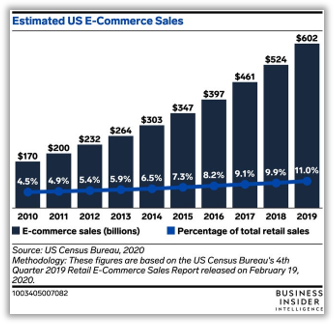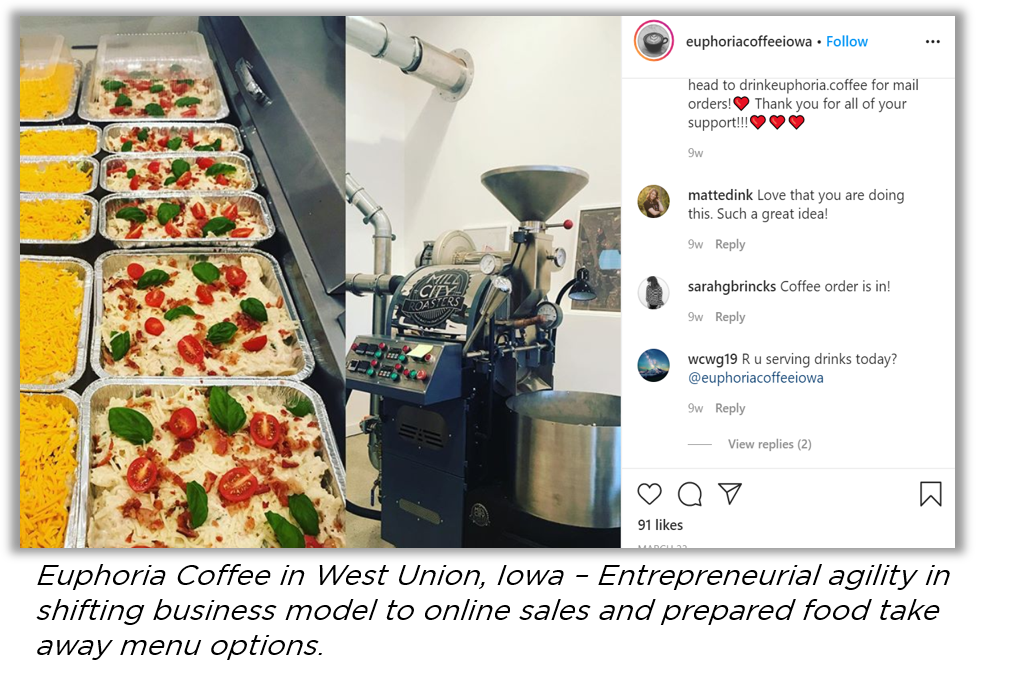June 30, 2020 | COVID-19 Trends and the Impact on Retail | By: Matthew Wagner, Ph.D., Vice President of Revitalization Programs, NMSC |
 This article is part of the COVID-19 Trends Blog Series.
This article is part of the COVID-19 Trends Blog Series.
Throughout history, there have been profound economic, technology, and societal shifts that have greatly influenced the kinds of products and services we consume and how we consume them. Examples include everything from the transition of DVD rentals to streaming services, bank tellers to ATMs, big box and malls to e-commerce and experiential shopping at “mom and pops”. And in many cases, these shifts have also resulted in new business opportunities; one only has to think how telephone calls to family and friends were partially replaced by services like Instagram or shifts in corporate dress code resulted in “business casual” apparel lines dominating clothing sales. As they say, when one door closes, another opportunity typically opens.
The two-part question that all place managers are asking now is: How will COVID-19 permanently impact retail shopping, and what types of new business opportunities will result?
Shifts in How We Shop
 Stay-at-home orders and the shutting down of millions of small businesses across the country triggered one of the most sudden and global shifts in how and what we consume. And in many cases, the shutdown accelerated existing shopping trends. For example, e-commerce sales in the United States totaled more than $600 billion and made up 11 percent of all retail sales in 2019. According to the June 2020 US Ecommerce 2020 report from EMarketer, US consumers are expected to spend $709.78 billion on e-commerce in 2020. This figure represents an increase of 18 percent in e-commerce spending, and 14.5 percent increase of overall retail spending. Bricks-and-mortar retail spending, however, is expected to decrease 14 percent.
Stay-at-home orders and the shutting down of millions of small businesses across the country triggered one of the most sudden and global shifts in how and what we consume. And in many cases, the shutdown accelerated existing shopping trends. For example, e-commerce sales in the United States totaled more than $600 billion and made up 11 percent of all retail sales in 2019. According to the June 2020 US Ecommerce 2020 report from EMarketer, US consumers are expected to spend $709.78 billion on e-commerce in 2020. This figure represents an increase of 18 percent in e-commerce spending, and 14.5 percent increase of overall retail spending. Bricks-and-mortar retail spending, however, is expected to decrease 14 percent.
While this is not entirely unexpected considering the circumstances, the question remains whether these shifts will become permanent post-recovery. It is further complicated by the fact that some states are now halting their reopening phases due to an acceleration in COVID cases. Given that research suggests that it takes 66 days on average to form new habits and can range from as little as 18 days to 264 days, one can assume that millions of America consumers have already formed new methods for shopping and interests in certain products and services have also been heavily influenced.
What’s Likely to Stick?
While e-commerce sales may pull back from their accelerated growth rate once a vaccine is in place and old norms form with new norms, small business owners should still be making fundamental shifts in how they reach and sell to consumers. Main Street America’s research report The Impact of COVID-19 on Small Businesses revealed that more than two-thirds of mom and pop businesses did not have an e-commerce sales channel. Of the third that did, e-commerce sales represented less than one-quarter of overall business sales.
 During this time, we have also seen more small business owners—and not just those in the restaurant industry—adding delivery and pick-up options for consumers. We should anticipate that this pre-COVID trend will continue after the pandemic is over and become standard practice for mom and pop businesses. From a place management perspective, Main Streets will need to think about infrastructure elements such as street design, open streets, and placemaking features that will be necessary to support small business owners in our downtowns and neighborhood commercial districts.
During this time, we have also seen more small business owners—and not just those in the restaurant industry—adding delivery and pick-up options for consumers. We should anticipate that this pre-COVID trend will continue after the pandemic is over and become standard practice for mom and pop businesses. From a place management perspective, Main Streets will need to think about infrastructure elements such as street design, open streets, and placemaking features that will be necessary to support small business owners in our downtowns and neighborhood commercial districts.
A third and likely permanent shift will be the increasing separation between how consumers use e-commerce shopping versus bricks-and-mortar shopping. Over the past decade, consumers began to shop more aggressively online for a combination of price and convenience. This trend started with electronics and books, although niches have formed to create a rise in independent book sellers once again. Over this time, additional bricks-and-mortar stores carved out a shopping niche based on experience, community engagement, place assets (think breweries and historic architecture), and leisure fueled by restaurants, bars, and unique products. In fact, food away from home exceeded that of grocery store sales for the first time in 2019. For more on this subject, check out Main Street America’s recent publication The Future of Retail: Creative Approaches to Place-Based Entrepreneurship which remains even more profoundly substantive in a COVID recovery.
While consumers are likely to continue to focus on essentials rather than wants in the near-term, long-term e-commerce cannot serve as a replacement for what humans need and crave: connection to people, place, and products that speak to their individualistic nature. We have seen some early indications to suggest the importance of the first two—connection to others and place—in people’s lives, whether in the exuberance of hanging out in bars post-reopen proclamations, or the heart-felt commitment of local residents supporting local businesses through gift card and delivery/pick-up purchases during stay-at-home orders.
We can glimpse the importance of the third human craving—connection to product—in e-commerce sites like Etsy. By featuring the products of independent makers, artists, and artisans, Etsy may represent the best online example of experiential shopping from a product perspective. In fact, Etsy estimates suggests a large number of Esty vendors also have bricks-and-mortar locations. And while overall e-commerce is up 18 percent in 2020, Etsy’s April 2020 sales exploded up more than 100 percent year over year to $781 million. This drastic expansion represents the site’s largest sales increase since becoming public in 2015. The top selling item? You guessed it… masks! Indeed, experiential and unique products that says something about you personally remains highly sought after when it comes to leisure-based shopping.
What Does This Mean for Main Streets?
Throughout 40 years of place management on Main Streets, we’ve learned that despite consumer interests, changes in the economy, or shifts in how we live and work that alter  the retail landscape, downtown and commercial district revitalization efforts remain conditioned on applying a comprehensive approach.
the retail landscape, downtown and commercial district revitalization efforts remain conditioned on applying a comprehensive approach.
● Underlying local market and place assets;
● Engagement with the community reflective of diversity and inclusiveness;
● Remaining professionally managed; and
● Incremental (not big fix) change
● What they sell?
● Whom they sell it to?
● How they create community with their customers?
● How they will deliver their products?
● What makes them unique and why will their customers return (value proposition)?
Check out Part 2 of this two-part blog post where I address new retail and service opportunities resulting from COVID trends. As a teaser… have you thought lately about the casualization of your “ZoomAttire”?
Disclaimer: This material has been prepared for informational purposes only and is not intended to provide, and should not be relied on for legal, insurance, liability, tax, or accounting advice. You should consult your own legal, insurance, tax, and accounting advisors for guidance on these matters.
Meet the Author
 Matthew Wagner, Ph.D., Vice President of Revitalization Programs: Matthew Wagner, Ph.D. serves as Vice President of Revitalization Programs at the National Main Street Center, Inc. In this role, he is responsible for driving the Center’s field service initiatives including the development and delivery of technical services for Main Street America and Urban Main programs, directing the Center’s new research agenda, as well as professional development programming through the Main Street America Institute.
Matthew Wagner, Ph.D., Vice President of Revitalization Programs: Matthew Wagner, Ph.D. serves as Vice President of Revitalization Programs at the National Main Street Center, Inc. In this role, he is responsible for driving the Center’s field service initiatives including the development and delivery of technical services for Main Street America and Urban Main programs, directing the Center’s new research agenda, as well as professional development programming through the Main Street America Institute.
Read Matthew's bio.




